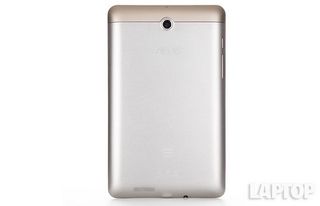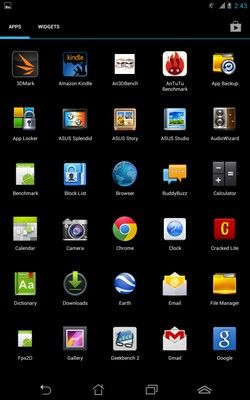ASUS FonePad Tested: Should Anyone Buy a 7-inch Phablet?
Has the phablet trend officially jumped the shark? It was only a matter of time before the drive to create ever larger smartphones resulted in a device so massive that it would force the market to recognize its own hubris, and that product is the ASUS FonePad. Packing an Intel Atom processor, the Android-powered 7-inch FonePad makes the 5.5-inch Galaxy Note II look like a Happy Meal toy. So is this device just the next evolutionary step in phablet design, or is it simply too much to handle?
Editors' Note: ASUS told us that the FonePad will not be available in the U.S. but allowed us to test the device for a technical preview.
Design
The FonePad is the smartphone the Incredible Hulk would use if he wasn't busy rampaging through the streets of Manhattan. Measuring 7.7 x 4.7 x 0.4 inches and weighing 11.2 ounces, the FonePad dwarfs competitors like the 5.5-inch Galaxy Note II, which measures 5.9 x 3.2 x 0.37 inches and weighs 6.4 ounces. The FonePad is closer in size to the Google Nexus 7 (7.8 x 4.7 x 0.4 inches and 12 ounces).
Size aside, the FonePad is certainly a handsome looking device. Following many of the design cues used with the ASUS Transformer Pad Infinity, the FonePad's face is covered in a glossy coating that stretches to all four corners of its black bezel. Above the display is the phablet’s earpiece, to the right of which is a 1.2-megapixel camera. Below the display is a simple grey ASUS logo.
You won’t find any physical face buttons on this big boy. Instead, like most Android tablets, you control the FonePad via four soft-touch Android buttons. A power button and volume rocker rest on the FonePad’s left edge, while microUSB and headphone jacks sit on its bottom edge.

The FonePad’s back panel features a champagne-colored metallic finish that gives way to a removable, textured cover for its microSIM and microSD card slots up top. Unfortunately, there was a significant gap between the cover and the FonePad’s rear panel that made the phablet look a bit sloppy. Below the cover is the FonePad’s 3-megapixel camera. The bottom of the back panel is the FonePad’s external speaker and, since this is an Atom-powered device, an Intel logo.
Stay in the know with Laptop Mag
Get our in-depth reviews, helpful tips, great deals, and the biggest news stories delivered to your inbox.
Using the FonePad as a phone is an exercise in futility. Folks with smaller hands will struggle to hold the phablet with one hand as they make calls. As a tablet, though, the FonePad is comfortable to hold and use.
Display and Audio
Like the Nexus 7, the FonePad rocks a 7-inch 1280 x 800 IPS display. However, while watching a trailer for “Man of Steel,” the image on the FonePad looked more colorful and detailed. ASUS has also included its ASUS Splendid app, which allows you to customize the display’s white balance, color saturation and hue.
The FonePad's default brightness setting doesn't impress, as the phablet registered 192 lux on our light meter. By comparison, the Samsung Galaxy Note II registered 240 lux , while the smartphone category average is 299 lux. On the tablet side of things, the Nexus 7 notched 314 lux on our brightness meter, while the category average is 372 lux.
Thankfully, the FonePad features an Outdoor mode that significantly increases the brightness. With this mode active, the FonePad’s display jumped to 303 lux. Just keep in mind that you'll get less battery life with this setting on.
Our biggest problem with the FonePad was how easily it collected fingerprint smudges. We spent a good deal of time just wiping the slate clean, as it were.
Audio from the FonePad’s rear-mounted external speaker was loud enough to fill a small conference room, but its quality was somewhat lacking. Even with the included ASUS AudioWizard set to Music Mode, songs sounded brassy. Other audio modes, including Movie Mode, Recording Mode, Gaming Mode and Speak Mode made the songs sound hollow.
Keyboard

ASUS packed the FonePad with both a stock Android keyboard and its own ASUS keyboard. Both keyboards were easy to use, though we wished the ASUS board didn’t require us to press the Alt key in order to use a comma. We also found the position of the ASUS keyboard’s delete key next to the L key to be slightly inconvenient, as it resulted in quite a few typos. We did, however, like the ASUS keyboard’s Next Word Prediction and Word reselection features.
MORE: 5 Best Keyboard Apps for Android
Software and Interface
ASUS loaded the FonePad with a lightly skinned version of Google's Android Jelly Bean. In fact, beyond the few additional features offered through ASUS’ Customized Settings menu, the FonePad is running what amounts to stock Android. Customized Settings includes a new Notifications drawer that lets you toggle the phablet’s Wi-Fi, Mobile Data, Smart Savings, Instant Dictionary, Mobile Hotspot, Bluetooth, GPS, Vibrate and other features.

Other options include the ability to adjust the display’s brightness and quickly access the Wi-Fi and ASUS AudioWizard menus. There's also the aforementioned Outdoor Mode, which increases the display’s brightness to improve usability in direct sunlight; Screenshot and Screenshot Editor; a screen saver and mouse controls.

Perhaps the best addition ASUS made to Jelly Bean is its Floating Apps feature. Like Samsung’s Muilti Window View, Floating Apps allows users to run multiple apps in individual windows at the same time, including the Browser, AudioWizard, BuddyBuzz, Calculator, Calendar, Countdown, Dictionary, Email, Sticky Memo, Stopwatch, To Do List and Video Player. If that’s too many options, you can always edit the list, paring it down to only the apps you want. To access the feature, you simply tap the arrow icon in the bottom right corner of the screen next to the Recent Apps button.
Of course, you still get the same five home screens found on Android Jelly Bean, as well as the omipresent Back, Home and aforementioned Recent Apps buttons at the bottom of the screen. Above that you have, from left to right, the Dialer app, Contacts, Messages, Apps menu, Browser, Play Store and Camera icons. And just like stock Android, the lock menu allows you to swipe to unlock, to the Camera app or to Google Now. Unfortunately, these shortcuts can’t be modified.
Apps

In addition to the usual Android fare, ASUS includes first party apps like the aforementioned ASUS Splendid and AudioWizard. You also get ASUS Story, essentially a storybook maker, and ASUS Studio, which lets you make photo and video albums. BuddyBuzz lets you keep track of your friends’ social media updates, while Block List will block specific numbers when they call your line.
Sticky Memo and SuperNote Lite let you take notes using the Android keyboard and handwriting recognition, respectively. Other apps include Instant Dictionary, My Painter, Press Reader, Web Storage and Zinio.
MORE: 25 Best Android Apps
Performance
In addition to being what amounts to a giant phone, the ASUS FonePad stands out because what's under the hood. Instead of opting for the quad-core Nvidia Tegra 3 processor (like Google’s Nexus 7), ASUS strapped the FonePad with a 1.2-GHz single-core Intel Atom Z2420 processor and 1GB of RAM. This CPU proved its worth during our real-world testing. Games like “Super Monsters Ate My Condo” ran smoothly, and apps opened and closed in a flash.
The FonePad offered solid performance numbers on the Quadrant benchmark, scoring 6,151. That easily outclasses the smartphone and tablet category averages, which are 3,816 and 3,240, respectively. And while the FonePad crushed the Nexus 7’s score of 3,357, the Samsung Galaxy Note II scored a slightly higher 6,221. The 5.5-inch LG Optimus G Pro, with its Snapdragon 600 processor and 2GB of RAM, smoked the competition with a score of 12,075.
On the An3DBench graphics test, the FonePad was neck and neck with other devices, scoring 7,579. That’s better than the tablet category average of 7,362, as well as the smartphone category average of 7,241, not to mention the Optimus G Pro, which scored 7,556. The Note II (7,589) barely beat out the FonePad, while the Nexus 7 scored a higher 7,782.
Web Browsing

The FonePad isn't destined for the U.S. and will be sold primarily in Europe ,which means it only runs on a 3G HSPA data connection. As a result, the FonePad's antenna hasn’t been optimized for use in the States, so our testing isn’t meant to serve as an official representation of the phablet’s Web speeds. That said, when we tested the FonePad on AT&T’s HSPA network, we recorded an average download speed of 4.3 Mbps and average upload speeds of 1.31 Mbps, which is relatively impressive. Websites loaded just as fast, ESPN.com’s mobile site loaded in 6.5 seconds and Laptopmag.com took 7.8 seconds. The NYTimes.com’s desktop site took a bit longer to load at 12.6 seconds.
Camera and Camcorder

ASUS says that the camera software on our FonePad unit are not optimized for the U.S. market, which could explain why we saw slow focusing. That said, images taken using the phablet’s 3-megapixel rear-facing camera were relatively sharp and colorful. A photo of a mailbox revealed small imperfections like chipped paint.
The 720p video shot using the rear-facing camera looked fairly clear, though stuttering made playback difficult to watch. We hope this was a result of non-optimized software as well.
Photos taken using the 1.2-megapixel front-facing camera were colorful, though a bit blurry, resulting in a loss of fine details.
Battery Life and Call Quality
On our LAPTOP Battery Test, which involves continuous Web surfing over 3G with the display brightness set to 40 percent, the FonePad’s 16Wh lithium-polymer battery lasted an excellent 11 hours. That’s about 4 hours longer than the tablet category average of 7:07. The Nexus 7 lasted 7:26.
We also ran the same test over HSPA, which resulted in a runtime of 6:03. The fact that the FonePad’s 3G connection hasn’t been optimized for the U.S. could lead to the phablet consuming an inordinate amount of battery life.
The FonePad offered solid call quality over AT&T’s voice network. A call to a friend’s landline sounded clear and static free. A call to a friend’s cell phone was equally clear, though the caller did report that our voice sounded a bit tinny. The FonePad's speakerphone sounded just as clear.
MORE: 10 Tablets with the Longest Battery Life
It's easy to dismiss the FonePad because of its huge size, but there are plenty of people around the world who are looking for a tablet that also happens to make calls. The question is whether you want a 7-inch phablet to be your primary device. As a tablet, the FonePad is a solid device, but it's simply too large to serve as a smartphone. The gadget is too big for normal pockets and holding it up to your face makes you look ridiculous.
However, if you plan to use a headset with the FonePad, you'll like the smooth performance offered by the Intel Atom processor and its long battery life (at least in Wi-Fi mode). We also appreciate the floating apps feature, which makes it easier to multitask. Just don't expect a great camera experience. Overall, the FonePad should find some takers, but we might wait to see what the Galaxy Note 3 has to offer.

Most Popular

